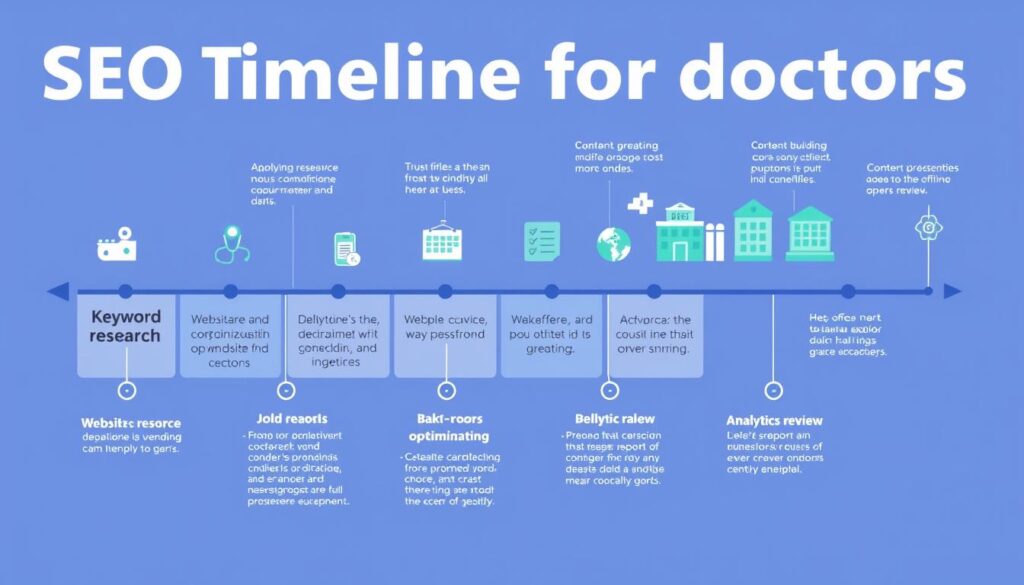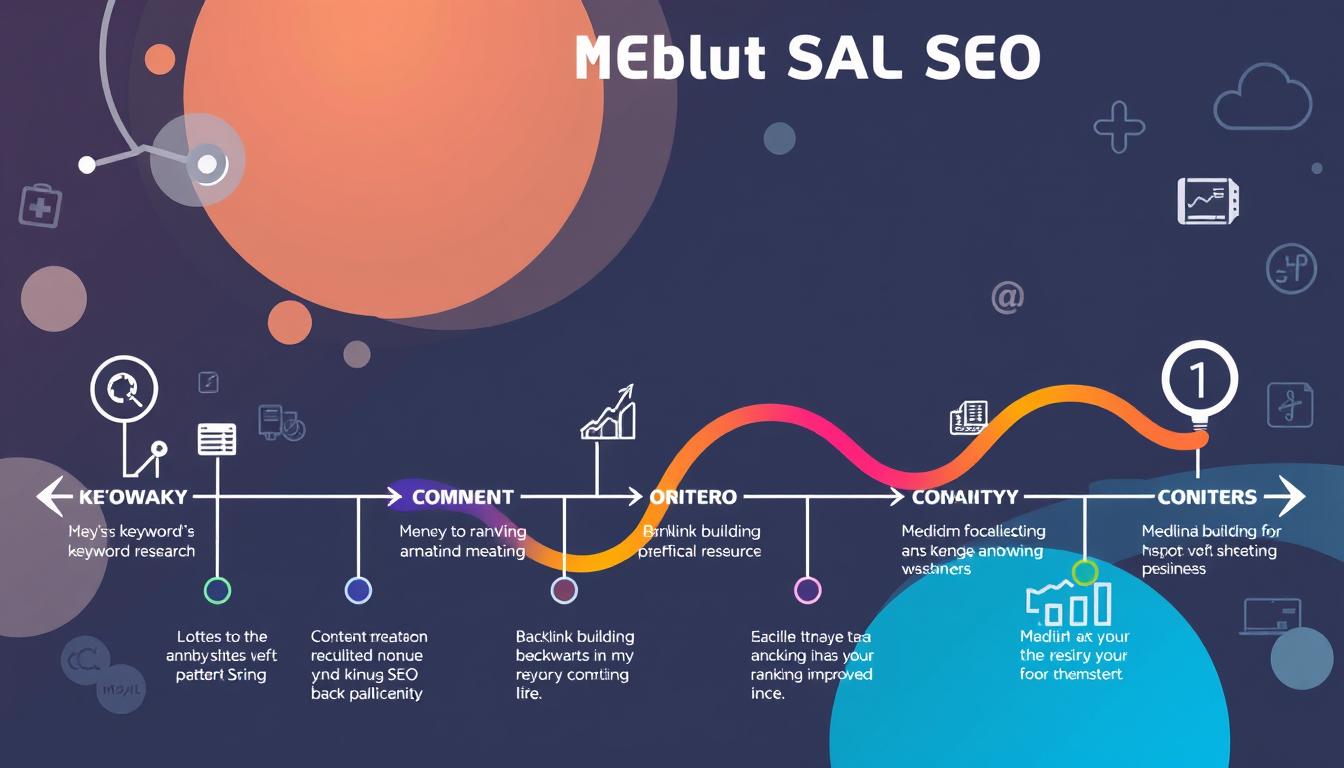Ever wondered why some medical practices are easy to find online, while others are hard to find? Knowing how long medical SEO takes is key for doctors wanting to be seen more online. The answer, how long does it take for medical SEO to work?, changes a lot. It depends on things like how old the website is, how competitive the field is, and how much effort is put into SEO.
Most medical practices see better rankings in four months to a year. But, every practice faces its own challenges. In very competitive areas, it might take longer, especially for new sites trying to get noticed. For more on making your healthcare SEO work faster, check out this detailed guide on how long it takes for medical SEO to.
Key Takeaways
- SEO improvements in medical practices typically take four to twelve months.
- The type of website (new vs. existing) significantly affects the timeline for results.
- Competition levels can affect how quickly practices see SEO success.
- Regular content updates and effective strategies can accelerate visibility.
- Understanding your audience and their needs is essential for optimizing SEO.
Understanding Medical SEO Basics
Medical SEO helps healthcare websites show up better on search engines. It aims to bring in more patients by making the website more visible online. This includes making content, finding the right keywords, and improving the website’s technical side. Many doctors don’t realize how important a good SEO strategy for doctors is for growing their practice.
What is Medical SEO?
Medical SEO is all about making doctors, clinics, and hospitals more visible online. The setup and optimization can take one to three months, depending on the website’s current state. It’s also important to focus on local SEO since patients often look for providers close to them. Plus, with more health searches happening on mobiles, making websites mobile-friendly is key.
Why is SEO Important for Healthcare Professionals?
With over 70,000 health-related searches on Google every minute, being seen online is crucial. Patients check online reviews when choosing healthcare providers. This shows how important having a strong online presence is. By using healthcare SEO basics, doctors can use patient feedback to improve their reputation and attract new patients. A good SEO strategy for doctors is also more affordable than traditional ads, helping practices stay afloat. Improving website speed and security also helps with SEO and user experience.
How Long Does It Take For Medical SEO To Work?
Understanding the timeline for medical SEO is key for healthcare professionals. Knowing how long it takes to see results helps set expectations and shape strategies. SEO efforts often show initial results in 4 to 6 months. But, reaching the full potential of a good SEO strategy can take up to 12 months or more.
This section looks at typical timeframes and what can affect them.
Typical Timeframes for SEO Results
Medical websites with strong SEO strategies see different results. Websites with a high domain authority might see changes in 3 to 6 months. Newer sites usually need 9 to 12 months to see big changes. Here’s what you can expect:
| SEO Activity | Timeframe |
|---|---|
| Initial results from ongoing keywords | 4 to 6 months |
| Full impact of SEO strategy | 9 to 12 months |
| Immediate gains from long-tail keywords | 3 to 6 months |
| Rankings for competitive keywords | 6 to 9 months |
Factors Affecting SEO Timelines
Many things influence the SEO timeline for doctors. These include:
- Website Age and Domain Authority: Older sites with good credibility rank faster than new ones.
- Website Health: Technical problems like slow loading times can slow down SEO progress.
- Content Volume: More quality content can help improve rankings.
- Link Profile: Backlinks from trusted sites boost credibility and speed up rankings.
- Competition Level: Keywords with lots of competition can take longer to rank well.

Key Factors Influencing Medical SEO Success
Medical SEO success depends on several key elements. These include the website’s age, domain authority, and the level of competition. Also, how well you allocate resources for SEO efforts matters a lot. Knowing these factors can greatly improve your website’s ranking.
Website Age and Domain Authority
The age of a website affects its domain authority. Older sites often have more credibility and backlinks. This trust helps them rank better in search results. Medical practices should work on building their web presence to show reliability to search engines and patients.
Industry Competition
The healthcare industry’s competition level is crucial for SEO success. In less competitive markets, sites can quickly appear in search results. But, in crowded areas, more effort and resources are needed. It’s important to understand the competition to create effective SEO strategies.
Resource Allocation for SEO Efforts
Effective resource allocation is key to SEO success. This means investing time and money in content, technical improvements, and SEO services. With enough resources, you can see faster improvements in rankings. Creating valuable, accurate content tailored to patient needs also boosts online visibility.
Strategies to Accelerate Medical SEO Results
In the competitive world of healthcare, medical practices can use many strategies to improve their SEO. By focusing on these strategies, practices can become more visible online and attract more patients.
Content Creation and Optimization
Creating high-quality content is key in content optimization for healthcare. Posting insightful articles and blog posts regularly boosts search rankings and builds trust. Using long-tail keywords, like “affordable anxiety therapy in [Your City]”, helps rank higher with less competition. Regular updates show search engines that the site is active, improving its ranking chances.
Technical SEO Improvements
Technical aspects are crucial for SEO success. Improving website speed, making it mobile-friendly, and optimizing structured data enhance user experience. Search engines favor websites that perform well, so improving these areas can lead to better rankings. Optimizing for local searches, like “therapist near me” or “counseling in [Your City]”, helps local patients find services easily.
Building Quality Backlinks
To increase online authority, building quality backlinks is vital. Working with reputable websites or writing guest posts can get valuable links. These links boost trust and rankings, making it important to engage in outreach and build industry connections.

| Strategy | Description | Benefits |
|---|---|---|
| Content Creation | Regular publishing of informative blog posts and articles. | Increases search rankings and builds patient trust. |
| Technical SEO | Website speed, mobile optimization, and structured data enhancement. | Improves user experience and search engine favorability. |
| Quality Backlinks | Collaborating with authoritative sites for link building. | Enhances website authority and search rankings. |
By using these strategies, medical practices can improve their online presence and better serve their audience. For more detailed information, check out this comprehensive guide. Continuous efforts and adapting to SEO changes are key for lasting success.
Measuring Medical SEO Success
It’s key to know if your medical SEO is working. You need to look at the data and analyze it well. This helps healthcare practices see their online presence better.
Key Performance Indicators (KPIs)
SEO KPIs show how well your SEO is doing. Important ones are:
- Organic Traffic: Shows how many visitors come from search engines.
- Keyword Rankings: Checks your site’s ranking for key words.
- Patient Conversion Rates: Sees how many visitors turn into patients, aiming for 4.2% or more.
Keeping an eye on these metrics helps spot what’s working and what’s not.
Using Analytics Tools
Using SEO analytics tools is crucial for medical practices. Tools like Google Analytics are very helpful. They give insights on:
- How users interact with your content.
- What sources bring in patient inquiries.
- How different pages on your site perform.
Regular checks with these tools help improve strategies. This keeps healthcare providers ahead in the online world.
| KPI | Benchmark | Description |
|---|---|---|
| Organic Traffic | Varies | Total number of visitors from search engines |
| Keyword Rankings | Top 10 | Position of targeted keywords on search results |
| Conversion Rate | 4.2%+ | Percentage of visitors who engage as patients |
Conclusion
Knowing the timeline for healthcare SEO is key for medical professionals wanting to boost their online presence. It often takes at least six months to see big changes, and sometimes up to two years. Many things affect how fast you see results, like the website’s age, competition, and how you use your resources.
Google’s algorithms change often, so it’s important to keep up with these updates. This helps keep your ranking strong.
Creating a solid SEO plan means focusing on quality content and technical improvements. Posting valuable medical content regularly and making your site fast and easy to use can really help. Also, getting authoritative backlinks is crucial for better rankings.
By working on these areas, healthcare providers can engage more with patients and grow their online presence. This makes it easier to attract more patients.
Dealing with the challenges of healthcare SEO can be tough. That’s why working with an expert agency, like Revenue Boomers, might be a good idea. They can help you understand SEO better and improve your online visibility and patient numbers in a competitive digital world.






